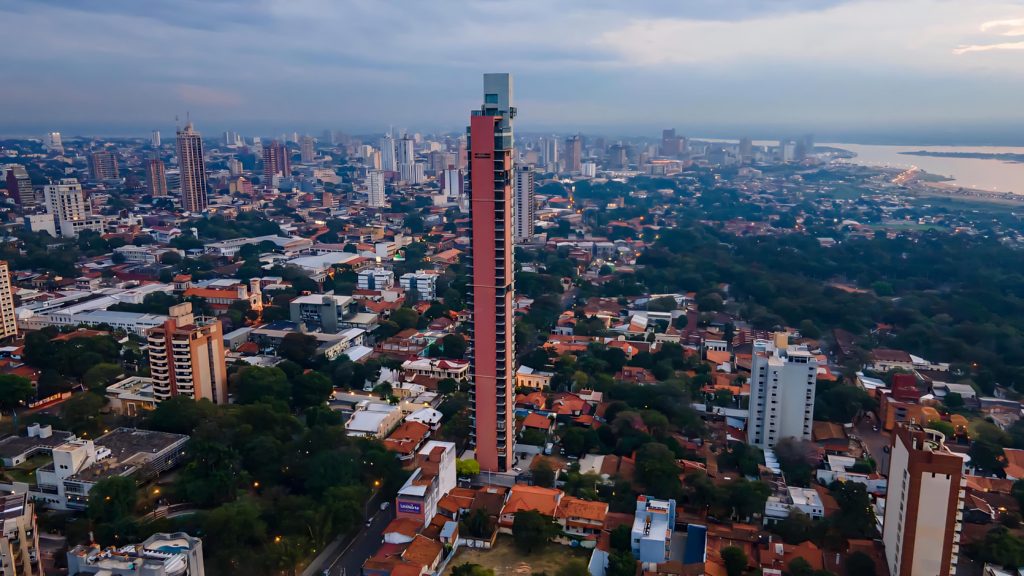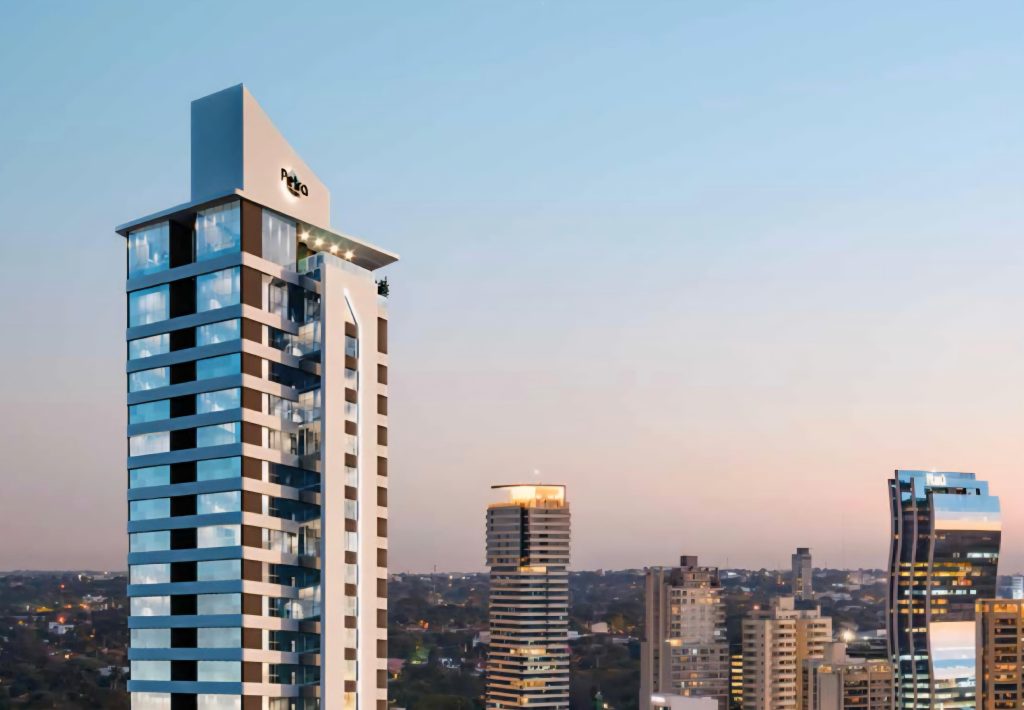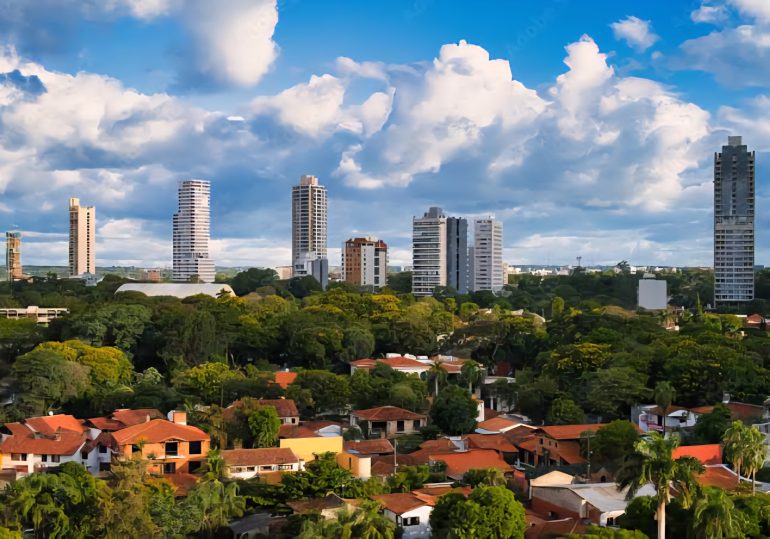For much of the 20th century, Asunción, the capital of Paraguay, was a low-rise city. Its streets were lined with modest houses, colonial façades and small commercial buildings. In the last three decades, however, Asunción’s skyline has changed dramatically: tower cranes have become part of the urban landscape, and the city’s horizon now features high-rise towers that reflect both economic growth and architectural ambition.
This vertical transformation is the result of several converging factors: economic dynamism, openness to foreign investment, infrastructure modernisation, and the vision of local and international developers determined to take Asunción skywards.
The first giants
The city’s vertical history began with a milestone: Wilson Tower. Inaugurated in 1993, it rose to 107 metres with 31 floors, holding the record as the tallest building in Paraguay for nearly two decades. Built in the brutalist style, it did not aim to dazzle with ornamentation, yet became a symbol of modernity for its time.
That reign ended with the completion of Icon Tower, structurally finished in 2014 but officially inaugurated in 2019 after delays caused primarily by financial constraints. Rising 142 metres with 37 floors, it surpassed Wilson Tower not only in height, but also in architectural vision.
The building introduced open-plan lofts that owners could personalise, alongside advanced engineering designed to withstand seismic activity and strong winds. Despite the setbacks during its development, Icon Tower now houses a community of residents and stands as a distinctive landmark on Asunción’s skyline, attracting both locals and visitors.

A growing skyline
The momentum did not stop there. In 2021, Jade Park concluded on Santísima Trinidad Avenue with three residential towers named after Paraguayan flora: Lapacho (135 metres, 33 floors), Jacarandá (110 metres), and Trébol (95 metres). This luxury development combined spacious residences, green areas and an exclusive clubhouse.
Another notable addition is Sky Tower, standing 123 metres high with 35 floors on Santa Teresa Avenue, offering premium services for a discerning clientele. Such developments mark a new phase in which height blends with design, sustainability and lifestyle quality.
The names behind the change
Asunción’s urban shift is inseparable from the companies driving it. Fortaleza, with over 31 years in the real estate market, has become a household name. Its portfolio includes Fortaleza Boggiani (31 floors, 200 apartments) and the future Torres Carmelitas (33 floors each), set to be one of the most exclusive residential complexes in the city. Fortaleza has also been recognised for its accessible savings and investment model, providing legal security for its clients.
Salum & Wenz has also made its mark, delivering projects such as the Lumiere Mariscal and the SARIC Corporate Building, and achieving environmental certifications like LEED (Leadership in Energy and Environmental Design). Notably, the Casa Rica Gourmet Market became the first retail building in the country to earn this certification, while the Holiday Inn Express Asunción reached LEED Platinum status.
Altius Group and Habitalis have raised the bar for residential standards. Projects such as More del Sol, designed by acclaimed architect Carlos Ott, and Habitalis Mburucuyá focus on natural light, cross ventilation and smart technology, embracing the concept of Wellness Design. The project More also extends to More Mariscal and More Plaza.
Looking higher: The leap to the monumental
While the past two decades brought steady growth, the coming years promise an unprecedented leap. Several projects under construction will surpass all current records. One of the most ambitious is Petra Imperiale, developed by Petra Urbana. Once completed, it will become Paraguay’s tallest residential tower, reaching 250 metres with 73 floors.

It will feature a mixed-use complex including an NH Collection hotel and a corporate tower. The concept of Resort Living will offer luxury amenities in the sky, such as a spa on the 61st floor. Close behind in scale is Paseo 55, from Blue Tower Ventures Paraguay. This 212-metre, 55-floor tower will be among the tallest in the Southern Cone, with direct connection to Paseo La Galería. Its facilities will include a rooftop on the 55th floor with pools and 360-degree panoramic views.
Another forthcoming highlight is Petra Tower, a 170-metre, 44-storey development that will strengthen the high-rise corridor along Avenida Santa Teresa and is slated for completion in 2025. Equally ambitious is Sudameris Plaza, which will stand 188 metres tall with 39 floors, serving as the future headquarters of Sudameris Bank.
Beyond height: Quality, sustainability and vision
Asunción’s boom in skyscrapers is not merely about breaking height records. Each new building incorporates advances in engineering, safety, energy efficiency and design aimed at improving residents’ quality of life. LEED certification, once rare in Paraguay, is now a common goal among developers, aligning local construction with international sustainability standards.
The clustering of these towers in areas such as Avenida Santa Teresa, Molas López, Carmelitas and the Costanera is also reshaping the urban dynamic, attracting commercial spaces, offices and cultural venues that enhance the surrounding neighbourhoods. What was once a flat horizon is now a mosaic of forms, heights and styles that tell a story of ambition and reinvention.
The race for the tallest building will undoubtedly continue, but the city’s future will not be defined solely by metres and floors. The true measure of success will be how each new construction contributes to a more vibrant, connected and sustainable capital. In the decades to come, Asunción will keep looking upward. Its skyline will remain in motion, shaped by visionaries who see in every tower not just concrete and glass, but a symbol of a city determined to grow towards the clouds.


